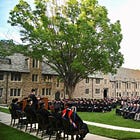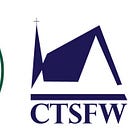Building Exits from the LCMS
The probabilities are rising for a new quasi-Lutheran denomination to emerge via schism or merger.
A high-altitude observer of the LCMS might conclude that multiple exits are currently under construction to funnel parishioners and assets away to one or more new church bodies. The reason for all the building is that the “Missional” side of the LCMS chafes against the commonly held and understood forms, symbols, and systems of the Synod’s Lutheran identity.
Lutheran identity can be a greased pig because doctrine, theology, and church bodies are not numbered players on a sports field wearing set uniforms and following an agreed rule book. Nevertheless, church bodies, like all groups and organizations, have developed markers and signals to let everyone know who they are and what they believe teach, and confess.1
The primary purpose of boundary markers for a church body is passive discipline starting with collective submission to the authority of Christ in and through Scipture. Knowing where the borders are fosters more sincere dealings among sinners and provides a starting point for the Church to harness the collective abilities, ambitions, and resources of its people for the purpose of serving God’s will until the return of the Lord Jesus.
Nobody should enter within the territory of the LCMS, even in the most distant hinterlands, under any illusion or misapprehension about what will be given and received. When people move the ancient boundary stones it is a recipe for chaos, whether that entails undermining the authority of the Bible or tampering with the established norms of culture, tradition, and governance in that voluntary collective.
Taking the offramp
Synod’s most visible and controversial offramp is “Texit.” A rebel alliance at Concordia University Texas (CTX) issued a unilateral declaration of independence from the Synod and, consequently, is in litigation with the LCMS to resolve several overlapping disputes about governance and asset ownership.
Texas District President Rev. Michael Newman, effectively the immediate senior theological and governance supervisor for CTX, has played a coy game in the situation, splitting the baby with admonitions for repentance from both sides and more dialogue, etc., etc. However, it would appear his sympathies lie with CTX with these examples of loaded language in his communications.
Compare:
exacerbated by the sudden and vociferous introduction of theological concerns by the President of Synod
with
some of the theological issues were due to carelessness on the part of CTX leadership. Others were concerns that should have been vetted through the CTX leadership before they were brought to the Synod President’s office.
Which is harsh and accusing, and which is mild and excusing?
DP Newman published Gospel DNA in 20162, which is something of a lodestar for the “Missional” faction of the LCMS that is building most of the off-ramps. The book is filled with catchphrases and buzzwords you will hear on repeat from that side of the Synod: Multiplication, Leadership, Context, Planting, Start, Community, Movement, Presence, Fear, Welcome, and so on. It echoes the evangelism sentiments espoused by American evangelicals who have brought business school philosophies to the church in a misguided attempt to boost Matthew 28 productivity.
The implicit common thread is that the gospel needs activation mechanisms, which are good deeds and valuable goodies placed in front of unbelievers.
The consequence is that theological and Synodical landmarks have been ploughed over in pursuit of growth at all costs. In the missional churches, Lutheran identity has been vacuum compressed to be just infant baptism and a light hat tip to the real presence in the Lord’s Supper. Even then, the once cherished and accepted forms and symbolism have been defaced.
The periphery
Another off-ramp that doesn’t need a telescope to be seen is the Center for Missional and Pastoral Leadership Formation (CMPL).
An affiliate of The Center, formerly Mission Partners Platform, CMPL is an online Master of Divinity (M.Div.) degree program awarded by the Institute for Lutheran Theology.
The Center was created in response to requests from congregations and church leaders for a quality, affordable, effective online degree program that would equip potential pastors and church workers for missional ministry in areas that are not currently being served. The focus is on contextual learning, where students can apply what they learn directly to their ministry training setting. The desire is for a program that enables students to study while continuing their work and careers.
The CMPL is aimed squarely at the LCMS’s Specific Ministry Program (SMP) in the first instance but logically becomes the substitute for the Synod’s residential seminary programs. The Missional spokesmen, mouthpieces, networks, and conferences are increasingly unambiguous about wanting the right to commission and ordain their own pastors and church workers, and the CMPL initiative considerably advances that desire.
Some of this was tracked through Kairos Seminary in Sioux Falls, SD, but it lacks the Lutheran identity that the ILT-sponsored degree provides. Kairos won’t necessarily be abandoned since an “all the above” strategy can also accomplish the goals, but there seems to be minimal traction among the Lutherans.
If SMP graduates have an asterisk next to their names now, CMPL M.Divs will have a double asterisk because they will not carry a certification for ministry from a Synod seminary faculty.
Halfway house synod
The only reason to pursue the CMPL M.Div degree for the “potential” of becoming a pastor is to be a pastor in actuality. Consequently, candidates must see that likelihood on the horizon to make the investment. So, which paths lead to ordination?
Four probabilities come to mind if the Missional cohort:
Controls the LCMS via a near-term election victory (2026 or 2029).
Very low probability.
Secedes from the LCMS.
High probability if CTX defeats the LCMS in court.
Low probability without CTX, and likely to fail in the medium term (7-14 years).
Joins the Lutheran Churches in Mission for Christ (LCMC). The LCMC quit the ELCA over the ordination of homosexuals and transsexuals, but retains female ordination.
Moderate to high probability with the ILT nexus and a shared permissive view of female authority.
Pioneers independent congregations and micro-Synods.
Only possible with independent financial resourcing through a benefactor or if a pastor is independently wealthy.
Based on its board and faculty profile, the ILT may as well be the LCMC Seminary. That said, there has been an infusion of LCMS-affiliated academics3, which should be triggering unionism alarms followed by doctrinal discipline.
Also noteworthy is that ILT is committed to mainstreaming radical Lutherans and, to that end, is establishing the Forde Center for Theology and Proclamation. That will raise more red flags for Confessionals, who have grown increasingly irritated with the continued promotion of Fordeian theology and acolytes like Steven Paulson at Concordia Theological Seminary, Fort Wayne (CTFSW), and in official Synod publications.4
Until recently, Concordia Seminary, St. Louis (CSL), was the Synod’s Missional bastion. However, Synodical elections have consequences, and one of the most profound since 2010 is that CSL is bounding back to its Confessional roots.
Without CSL’s original pipeline, a slow-motion existential crisis is unfolding for the Missional Lutheran ecosystem, which encompasses the tail of Jesus First (Congregations Matter), the Best Practises annual gathering in Arizona, the Pastoral Leadership Institute (PLI), Lutheran Hour Ministries, Five Two, the Michigan District Hymnal Project, and a host of evangelical/Baptist influenced congregations and their ministries.
The aggregate leadership of those organizations can also make decision trees and calculate probabilities absent a prophetic word from God. Therefore, it is hardly surprising that several former CSL staff have joined ILT to give the CMPL some heft.
Quo vadis?
There is no more schismatic development for a Synod than open warfare over how pastors should be trained, sent, and called. It is not hyperbole to think of this moment as the first gusts of another upheaval that will be as consequential as Seminex. Indeed, the spiritual welfare of the rank-and-file parishioners of the LCMS is at stake.
Consequently, it is a dangerous time for Missouri and it seems inevitable that a more formal fracturing is coming based on the signals being sent by the Missionals on so many fronts.
The clergy must go on the front foot to give more form and focus to what constitutes Lutheran identity so that the laity is not disarmed by pious claims about adhering to Scripture and the Book of Concord. Lutherans are not defined by a truncated loyalty to baptism, the real presence, and lip service to a quia subscription to the Book of Concord. The Missionals imported much that is alien to any Lutheran identity or context, and it should not just be waved away as jovial disputes over “wine, women, and song” and sacerdotal hypnosis.
This conflict is about AC XIV (what constitutes a “regular call”). If a large swathe of the Missional LCMS decides to upend what has been agreed and nurtured to allow Lutheranism to flourish in America, then it will be the faithful, educated laity that determines the long-term outcome. Rejecting Missional schism does not foreclose innovation and adaptation, it simply acknowledges that transformation does not require scuttling the best boats we have.
If you come across a marching band with mostly brass instruments, black uniforms with red accents, and playing the core British Christian hymns, you know it’s a Salvation Army organization. If the band is wearing kilts and playing bagpipes, you can figure out a Gaelic connection and then contextualize it further to be, say, a Boston Police funeral or a Protestant demonstration in Ulster.
Now, imagine yourself a movie producer making a film about Lutherans. Would you cast a pastor in a Hawaiian print shirt and bermuda shorts flanked by projection screens, a drum set, guitarists, and a singer clutching a microphone on a stage cluttered with expensive audio-visual equipment and cables? Would you further clue in the watcher by panning to a church sign advertising “Abundant GraceLife Pointe of the Valley”? Would you script the pastor to use derivative Words of Institution before throwing out his arms to declare, “Everyone is welcome to eat and drink,” as random parishioners start handing out shot glasses?
If you made that movie, it would be your last one, because you failed to provide any context clues to communicate Lutheran identity to the audience.
Rev. Newman’s book has several curiosities that will jolt Lutheran ears. For example, this statement, “[Jesus] arrived on earth as a baby, recruited twelve underachievers as disciples, and was overpowered and killed by angry church leaders.” Newman, Michael. Gospel DNA: Five Markers of a Flourishing Church, Loc 1008, Kindle Edition. It’s extremely weird to describe Jesus as “arriving on earth” as if He is just the interim visitor from Kolob. The claim that the twelve Disciples were “underachievers” is transparently false, as is the statement that Jesus was “overpowered and killed by angry church leaders.” Jesus submitted to be taken captive by Jewish civil and religious authorities who handed him over to the Roman civil authorities (John 19:10-11.) for propitiation of God’s wrath by Christ’s sacrificial death.
The most notable are Rev. Dr. Tim Ahlman, Rev. Dr. Ben Haupt, Rev. Dr. Steven Hein, Dr. Erik Herrmann, Rev. Dr. Todd Jones, Dr. Jack Kilcrease (LCMS CTCR), Rev. Dr. Jeffrey Kloha, Rev. Dr. Robert Kolb.
Writing for CTQ in 2020, Walter A. Maier III said, “In conclusion, while Forde confesses Jesus Christ as Savior, his position regarding salvation should not gain acceptance within The Lutheran Church—Missouri Synod. Based on his selective reading of Scripture and novel interpretation of passages, his teaching concerning the saving work of Christ and justification varies too widely from what is presented by the entirety of God’s Word and the Book of Concord. Despite Forde’s attacks, the doctrine of penal substitutionary atonement still stands, and must ever be taught and preached, to the glory of God, in faithfulness to Scripture, and for the everlasting spiritual welfare of many people.”








I pray that the faithful remnant in 'Missouri' are preparing for the reality it may be GOD's will for LCMS, LCC, WELS, et al. to finally have their lamps removed from their place of prominence on the Lampstand, as happened to the Church of Jerusalem. The future of orthodox, confessing Lutheran heritage in North America may well be the LCMS's English-Iowa-Dakota-Wyoming districts + the AALC. GOD's gracious providence for the establishing of Luther Classical College may be the mark that GOD is signaling this.
Also: beware of the bevy of adjectives being formed from nouns using the '-al' suffix, e.g. "Reformational", "Confessional", "Biblical", "Missional", "Liturgical", etc. In English syntax, the '-al' suffix indicates a "likeness" or "relation" to the noun, which preserves a certain degree of connection to the identity indicated by the noun (usually for branding/communication purposes), but does NOT necessarily indicate faithful adherence to what that noun fully represents.
By contrast, traditional Anglican bodies that broke from the wayward episcopal denominations & communions do not use '-al' to suffix their identifiers, they use '-ing' to indicate ongoing faithfulness to the heritage of the Reformations; e.g. 'Continuing Anglicans', 'Global Fellowship of Confessing Anglicans'.
This is a sharp analysis of the structural shifts underway in the LCMS. One thing that strikes me, though, is how quietly much of this plays out at the congregational level.
Many church members don’t realize these governance and formation changes are happening until they’re already downstream of the decision. The off-ramp is built long before anyone in the pews knows they’re being asked to follow it.
That’s what makes this moment so spiritually significant—not just for institutional integrity, but for the clarity and care being offered to those who have trusted their pastors and congregations to remain rooted in Lutheran confession.
It seems like real leadership would require not just building new structures, but making sure the laity understand what’s at stake before the church quietly takes the exit.